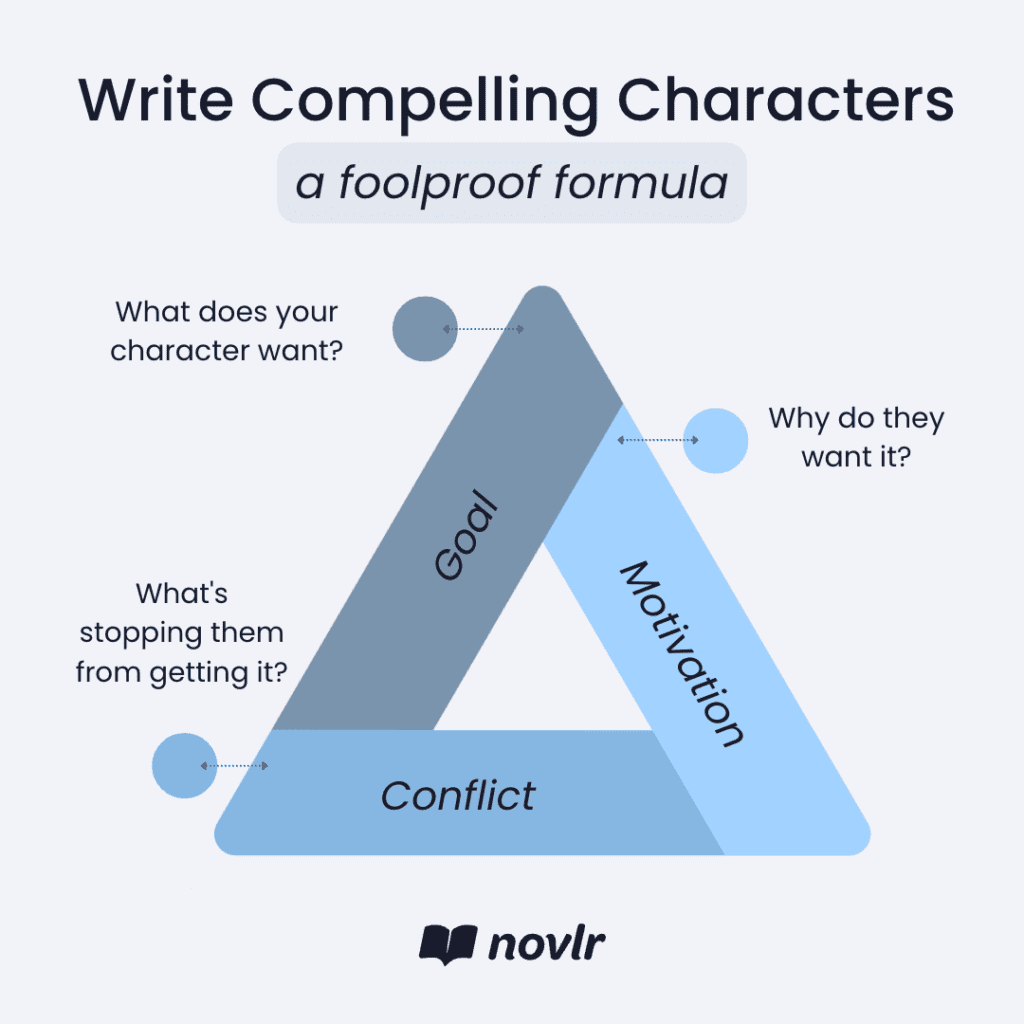Writing
How To Write Compelling Character Arcs
Have you ever been completely engrossed in a book and found yourself desperately invested in its characters? Those characters more than likely had well-crafted character arcs that kept you invested in their journey.
We all love to see characters evolve, don’t we? It’s that sense of progression and development that keeps us turning the pages of our favourite books. A well-crafted character arc can make a story memorable, relatable, and emotionally engaging.
Types of Character Arcs
Just like there are various flavours of ice cream to satisfy our taste buds, there are different types of character arcs to captivate readers’ imaginations.
- Transformational Arc: A character undergoes a profound transformation throughout the story. This transformational arc takes them on a journey of personal growth, where they evolve, learn from their experiences, and undergo significant change. Think Frodo Baggins from The Lord of the Rings, who starts as an ordinary hobbit and becomes a heroic figure, or Cinderella, who goes from being a mistreated servant to a princess.
- Flat or Static Arc: Not all character arcs involve drastic change or growth. In a flat or static arc, the character remains relatively unchanged throughout the story. Instead of personal transformation, these characters serve as a stabilizing force or a moral compass within the narrative. They maintain their core values, beliefs, or traits, providing stability and guidance for others. Sherlock Holmes is a prime example of a character with a flat arc. His brilliant deductive reasoning and logical nature remain consistent, while the world around him evolves.
- Positive Change Arc: In a positive change arc, a character starts with flaws, struggles, or a particular mindset, but over the course of the story, they experience personal growth and positive transformation. They learn valuable lessons, overcome obstacles, and develop into a better version of themselves. This arc is often associated with themes of redemption, self-discovery, and the triumph of the human spirit. Characters like Ebenezer Scrooge from A Christmas Carol or Katniss Everdeen from The Hunger Games exemplify positive change arcs.
- Negative Change Arc: Contrasting the positive change arc, the negative change arc delves into the descent or downfall of a character. It explores the moral decline, corruption, or internal conflicts that lead the character astray. This arc can be dark and intense, showcasing the destructive power of choices or external influences. Characters like Macbeth from Shakespeare’s play or Anakin Skywalker in Star Wars demonstrate the negative change arc.

Knowing the difference between a main character and a supporting character
Main characters and supporting characters play distinct roles in any narrative. Their involvement can significantly impact the development of character arcs as one takes centre stage, and the other feeds the story’s momentum.
- Main Characters: Main characters are the central focus of the story. They often drive the plot, face major challenges, and will be the primary arc characters. These characters carry the weight of the narrative on their shoulders and are usually who readers connect with the most. They have their own goals, motivations, and conflicts that shape their journey.
- Supporting Characters: Supporting characters, or secondary characters, are vital to the story but have less prominence than the main characters. They provide additional depth, conflict, and support to the main character’s arc. These characters may have their own subplots or challenges, but their primary purpose is to enhance the main character’s journey. They can be friends, family members, mentors, or even adversaries. Supporting characters bring diversity, relationships, and different perspectives to the narrative. They can have arcs of their own, but they are often simplified and stripped down so as not to take focus away from the protagonist(s).
Understanding the roles and functions of the main and supporting characters helps maintain a balance in storytelling. Main characters drive the narrative forward, carrying the weight of the story’s core conflicts and resolutions. Supporting characters provide valuable interactions, growth opportunities, and a sense of community or opposition for the main character.
When crafting character arcs, it’s important to consider how supporting characters contribute to the main character’s journey. They can challenge the main character’s beliefs, provide guidance or obstacles, or serve as catalysts for growth.

Goal, motivation, and conflict
When crafting character arcs, it’s essential to delve into the core elements that drive your characters: their goals, motivations, and conflicts. These elements provide the fuel for their development and shape the trajectory of their arcs.
- Goal: A character’s goal is what they strive to achieve throughout the story. It serves as their driving force, their purpose, and their destination. Whether it’s to find love, seek revenge, solve a mystery, or save the world, a clear and compelling goal creates a sense of direction for the character and propels their actions. The goal can evolve or change over time as the character’s arc unfolds, reflecting their growth or shifting priorities.
- Motivation: Motivation delves into the “why” behind a character’s actions and desires. It’s the underlying reason that fuels their pursuit of the goal. Understanding a character’s motivations adds depth and complexity to their arc. Motivations can stem from personal desires, values, past experiences, or external influences. They drive the character’s choices and provide insight into their emotional and psychological landscape. Strong and believable motivations make the character’s arc more relatable and engaging for the audience.
- Conflict: Conflict is the backbone of storytelling, and it plays a crucial role in shaping character arcs. It creates obstacles, challenges, and tension that characters must overcome. There are two primary types of conflict: internal and external. Internal conflict arises from the character’s inner struggles, such as battling with fears, doubts, or conflicting emotions. External conflict comes from external forces, such as antagonists, societal pressures, or environmental challenges. Both types of conflict force characters to confront their flaws, make difficult choices, and undergo transformation as they navigate their arcs.

The importance of backstory
Behind every character, there lies a rich tapestry of experiences, history, and personal baggage that shapes who they are. This hidden treasure trove is known as backstory, and it plays a crucial role in developing compelling character arcs. Let’s explore why backstory is so important in crafting well-rounded and relatable characters.
- Providing depth and dimension: Backstory adds depth and dimension to characters by revealing their past experiences, traumas, relationships, and formative moments. It gives context to their beliefs, motivations, and flaws. Just like real people, characters are influenced by their past, and understanding their backstory helps readers or viewers empathize with their journey. By fleshing out the backstory, you breathe life into the character, making them feel more authentic and multi-dimensional.
- Driving character motivations: Backstory is the key to unlocking a character’s motivations. Their past experiences and encounters shape their desires, fears, and ambitions. By exploring their backstory, you gain insight into what drives them, what they yearn for, or what they seek to avoid. This knowledge enables you to create more believable and relatable character arcs, as their actions and choices align with their personal history.
- Opportunities for growth: Backstory often includes significant moments of conflict, trauma, or challenges that characters have faced in the past. These experiences can become catalysts for growth and transformation throughout the arc. By referencing or revisiting the character’s backstory, you can create opportunities for them to confront unresolved issues, overcome fears, or learn from past mistakes. This adds a layer of complexity and personal development to their arc, making their journey all the more compelling.
- Generating plot points and conflict: Backstory can provide rich material for plot development and conflict. Unresolved conflicts, buried secrets, or unfinished business from the past can resurface, creating tension and driving the narrative forward. Characters may be forced to confront their past or face the consequences of previous actions, generating engaging conflicts and plot twists. This interplay between the present story and the character’s backstory adds intrigue and suspense, keeping readers hooked.

Character arc quick tips
- Start with strong foundations: Begin by establishing a solid foundation for your characters. Clearly define their goals, motivations, and conflicts. Know who they are at the beginning of the story and where they need to be by the end. This clarity will guide their arc and ensure consistency throughout.
- Embrace complexity: Avoid one-dimensional characters by giving them layers of complexity. Consider their strengths, weaknesses, fears, and desires. Characters should be a mix of virtues and flaws, making them relatable and human. This complexity fuels their growth and transformation.
- Show, don’t tell: Reveal character development through actions, dialogue, and behaviour rather than explicitly stating it. Allow your readers to witness the changes unfolding naturally. This creates a more immersive experience and allows for a deeper emotional connection.
- Balance internal and external conflict: Both internal and external conflicts contribute to character arcs. Explore the character’s internal struggles, such as emotional turmoil or conflicting beliefs, as well as external challenges they face in the world around them. Finding the right balance between these conflicts adds depth and tension to their journey.
- Create compelling relationships: Characters are shaped by the relationships they form. Develop meaningful connections between characters that influence their arcs. Friends, family, love interests, or mentors can provide support, conflict, or guidance, sparking growth and transformation.
- Utilize turning points: Identify key turning points in your character’s journey. These are pivotal moments where their beliefs are challenged, decisions are made, or revelations occur. Turning points drive the character’s arc and create opportunities for growth, conflict resolution, or self-discovery.
- Allow for ambiguity: Not every character arc needs a neat and tidy resolution. Embrace ambiguity and leave room for interpretation. Some arcs may end with open-ended questions or unresolved conflicts, leaving the readers or viewers contemplating the character’s journey beyond the story.
- Stay true to the character: Ensure that the character’s arc remains consistent with their established traits and experiences. Avoid forcing unnatural changes or contrived outcomes that don’t align with their development. Authenticity is key to creating believable and satisfying arcs.
- Evolve with the plot: As the plot progresses, consider how the character’s arc intersects with the narrative. Adjust the arc if necessary to maintain a harmonious balance between character development and plot advancement. Allow the arc to evolve organically alongside the story.
- Connect emotionally: Above all, strive to create an emotional connection between the audience and the character. Engage their empathy, invest them emotionally in the character’s journey, and elicit a range of emotions through the highs and lows of the arc.
By understanding the essence of character arcs, exploring different types, and distinguishing between main and supporting characters, you lay the foundation for compelling storytelling. Character arcs are more than just a transformation from point A to point B. They are journeys of growth, self-discovery, and overcoming obstacles. Through internal conflicts, believable motivations, and engaging backstories, characters come alive on the page, captivating your readers.